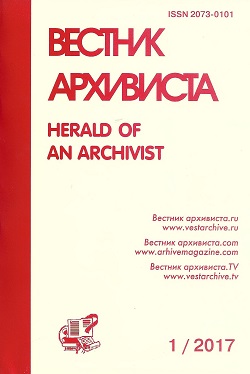УДК 94 (47).084.5 + 929.2
DOI 10.28995/2073-0101-2018-3-833-843
Mikhail V. Bryantsev
Acad. I. G. Petrovsky Bryansk State University, Bryansk, Russian Federation
Stalin as Imagined by the Population of Soviet Russia in 1920s
Abstract
Lenin's illness exacerbated struggles for succession among the ruling elite of Soviet and party leadership. While Trotsky's superiority seemed absolute, Stalin was coming to prominence. Using mechanisms of party influence, Stalin managed to force his opponents to the background and thus by 1926 took the place of the first party leader, to whom the population (mostly party comrades) increasingly turned. However, among the non-party masses there also rose voices of approval for Stalin's policy. It became obvious that he was to be established as Lenin’s sole successor. The task was facilitated by readiness of the population (primarily, peasants) to personify new power. However, analysis of ‘information’ materials, especially those preserved in provincial archives (of Bryansk, Gomel, Kaluga, Orel, and Smolensk) shows an ambiguity in perception of new leader by the population. Left in information vacuum and having little trust in official press, the population put credit in hearsay. Rumors that reached population (party members, before all) were unclear and incomprehensible. Many reprehended demands to harden attitude towards opposition, and even more, methods of combating it. Domestic and foreign policies, which increasingly became associated with Stalin’s name, were also found dissatisfactory. Even 1929 (Stalin’s 50th anniversary) with all praises sung and lip service paid, did not convince the population that Stalin was a worthy heir to Lenin. Any comparison was not in the former’s favor. However, when the collectivization began, Stalin’s figure became odious. The population was repelled by its methods and was not to be reassured by Stalin’s official speeches published in press. Resentment reached such a pitch that rumors sprang up about disagreements among Stalin's comrades-in-arms and even about his death, eagerly awaited by many. Stalin failed to convince even his fellow party members that his claims to the role of party theorist were justified.
Download the article: bryantsev_doi
Keywords
Stalin, political struggles, leader, opposition, party, rumors.
References
BRYANTSEV, M. V. Predstavleniya naseleniya sovetskoi provintsii o stroitel'stve sotsializma v SSSR v 1920-e gody [Narrative of socialism building in the Soviet periphery in 1920s. In Russ.]. IN: 1917 god v Rossii: sotsialisticheskaya ideya, revolyutsionnaya mifologiya i praktika: sb. nauch. tr. [1917 in Russia: Socialist idea and revolutionary mythology and practice: A collection of scientific works. In Russ.]. Ekaterinburg, Iz-vo Ural. universiteta publ., 2016, pp. 172-189.
BULDAKOV, V. P. Utopiya, agressiya, vlast'. Psikhosotsial'naya dinamika postrevolyutsionnogo vremeni. Rossiya, 1920–1930 gg. [Utopia, aggression, power. Psycho-social dynamics of the post-revolutionary period. Russia, 1920s-1930s. In Russ.]. Moscow, ROSSPEN publ., 2012, 759 p.
LIVSHIN, A. Nastroeniya i politicheskie emotsii v Sovetskoi Rossii: 1917-1932 gg. [Moods and political sentiments in Soviet Russia: 1917-1932. In Russ.], Moscow, ROSSPEN publ., 2010, 343 p.
STALIN, I. V. Zametki na sovremennye temy. Ob ugroze voiny [Notes on Contemporary Themes. The Threat of War. In Russ.]. IN: Stalin I.V. Sochineniya [Works]. Vol. 9. Moscow, Ogiz publ., 1948, pp. 322-330.
Chetyrnadtsatyi s"ezd VKP(b): Stenogr. otchet [The Fourteenth Congress of the C.P.S.U.( B.): Stenogr. report. In Russ.] Moscow, Gosizdat publ., 1926, 797 p.
SHALAEVA, N. V. Mekhanizm formirovaniya obraza vlasti v sovetskoi kul'ture 1920-kh godov (k voprosu o kul'te V. Lenina) [The mechanism of forming the image of power in the Soviet culture of 1920s: Revisiting the cult of Vladimir Lenin. In Russ.]. IN: Vestnik Saratovskogo gosudarstvennogo sotsial'no-ekonomicheskogo universiteta [Bulletin of the Saratov State Social and Economic University], 2009, no. 5, pp. 196–200.
About author
Bryantsev Mikhail Vasilievich, PhD in History, professor, Acad. I. G. Petrovsky Bryansk State University, head of the department, Bryansk, Russian Federation, +7-920-854-29-05, This e-mail address is being protected from spambots. You need JavaScript enabled to view it
Submitted 20.04.2018, published:
BRYANTSEV, M. V. Stalin v predstavleniyakh naseleniya Sovetskoi Rossii v 1920-e gg. [Stalin as Imagined by the Population of Soviet Russia in 1920s. In Russ.]. IN: Vestnik arhivista / Herald of an Archivist, 2018, no. 3, pp. 833-843. doi 10.28995/2073-0101-2018-3-833-843














